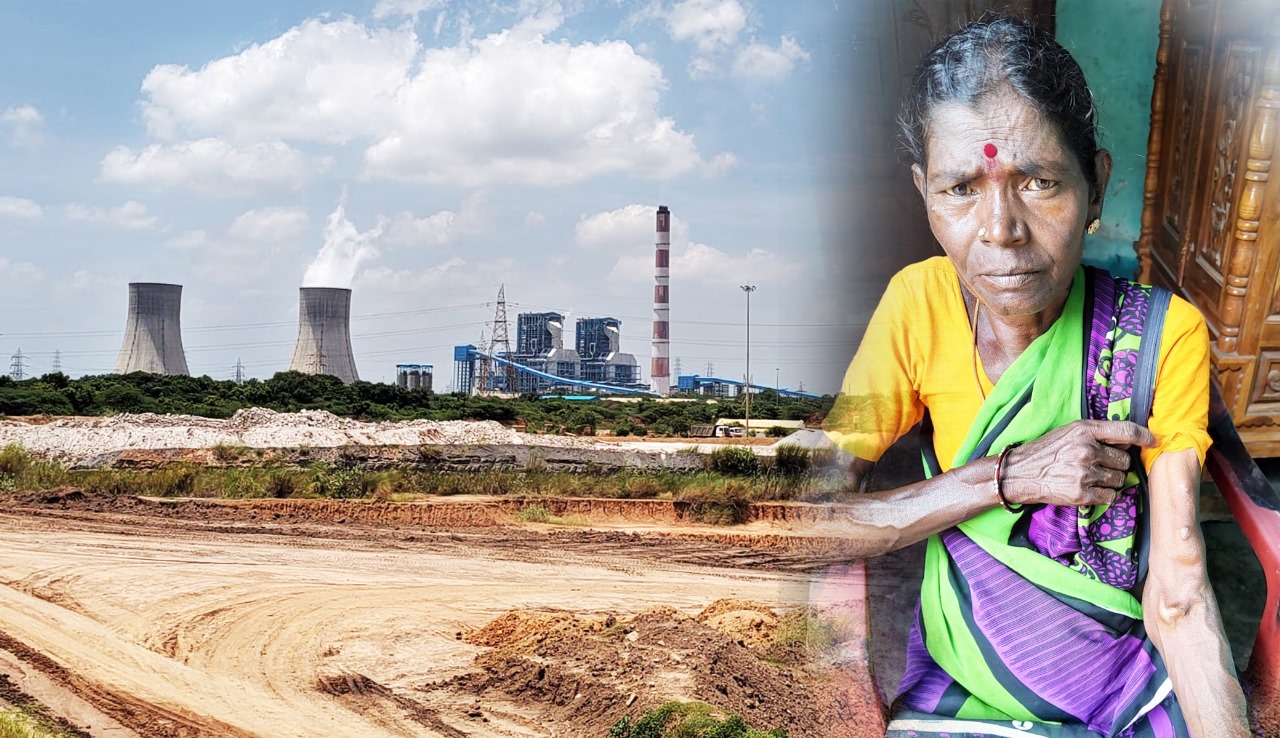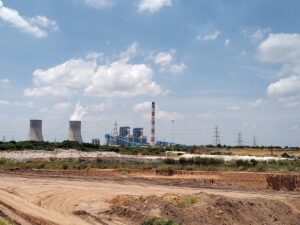Air and water pollution has reportedly left several villagers with chronic kidney disease, affecting their livelihood and pushing them to poverty.

Effluents from the Neyveli Lignite Corporation are being blamed for the high number of chronic kidney patients, like Indira Gandhi, in its neighbourhood. (Laasya Shekhar/South First)
Indira Gandhi loved a cup of hot tea after a long day’s work. She found the hot beverage energising.
Today, she hardly drinks tea, as her liquid intake has come down to half a litre a day.
Creases on her face make the frail woman look older than her 49 years. Her needle-poked arms resemble two protruding twigs with bulging veins.
Her mother had named her after the former prime minister, awed by the strong will and determination of the most prominent Indira Gandhi.
At Aadhandarkollai village in Neyveli in Tamil Nadu’s Cuddalore district, the lesser-known Indira Gandhi, too, is iron-willed and determined. Adversities have not bogged her down. Instead, she has been facing each day with a new resolve.
However, Indira’s resolve will not help her much as time is fast running out for her. Accompanied by her husband, she travels 50 km one-way to the Cuddalore Government Hospital twice a week to undergo dialysis.
“I used to earn ₹300 a day by cutting wood,” she told South First. On ‘hospital days’ she forgoes the income, besides shelling out as much to meet the travel expenses.
“I get treated for free. But we spend ₹300 per visit on bus fare and food. It is something we cannot afford,” she said. The couple make up for the loss by skipping a few meals during the week.
Indira was diagnosed with chronic kidney disease two years ago. With both kidneys damaged, her daily water intake is restricted to just half a litre. “This includes not just water but also tea and sambar,” she said.
“A cup of tea is a luxury I can no longer enjoy,” the woman sighed, knowing well that she would have to live with this condition for the rest of her life.
Indira is not alone in the village with contaminated groundwater suffering from chronic renal disease. “I know 10 residents from this village who undergo dialysis regularly like me. This doesn’t include a few people who haven’t disclosed their condition fearing taboo,” Indira said.

Photo of Indira Gandhi (inset) taken before she was diagnosed with chronic kidney disease. (Laasya Shekhar/South First)
Residents who are diagnosed with kidney failure are afraid that they would be thought of as weak if their condition is known.
Five patients South First met at Aadhandarkollai exhibited similar features: Discoloured skin, skinny limbs, and needle marks on arms with bulging veins. Of the five, only two had a history of smoking and drinking. While three of them undergo dialysis regularly, two others survive on tablets.
Failed kidneys have not only presented them with an uncertain future but also affected them physically, preventing them from working and pushing them to poverty.
Indira still chops wood, a task that leaves her breathless and fatigued. “Every year, one of us dies. I envy them,” Indira said, before picking up her axe to chop the wood.
While Indira can still work with difficulty, J Manikandan of the same village mostly sits or lies down. The 42-year-old farmer was diagnosed with a kidney condition a year ago.
The father of two has difficulty sleeping. Both his legs are swollen, and he can barely walk a few steps before stopping to catch a breath. He is depressed over his inability to provide for his family.
Earlier, he used to grow groundnuts and pearl millet on his 1.25 acre farm. Now, his wife and his brother take turns on the farm. The yield is barely enough to cover his medical expenses coming to ₹2,000 a month. Manikandan was an occasional drinker more than five years ago.
“I go to the Cuddalore Government Hospital every Monday and Thursday. A day after dialysis, I could eat two idlis without struggling. It is not possible on other days,” Manikandan told South First.
“I can sip water only when my throat is parched. I cannot breathe if I drink more than half a litre of water a day,” he added.
For the farmers who rely on meagre income from agriculture, dialysis is an exorbitant expense. In an earlier report, South First said Neyveli has become an “ashtray”, thanks to the Neyveli Lignite Corporation (NLC) India Limited’s dumping of fly ash resulting in poor agriculture yield.
Farmers in the region blamed the NLC for polluting the air and water. The region has impermissible levels of heavy metals, which have allegedly caused kidney ailments, skin diseases and respiratory issues among many others.
P Adilakshmi, a 54-year-old villager has been undergoing dialysis three times a week at the Mahatma Gandhi Medical College and Research Institute, Puducherry, for the past five years.
The hospital is about 60 km from her residence. The family has spent lakhs on her treatment, yet her condition has not improved. Adilakshmi’s family borrowed money at high interest to continue her treatment.
“Debts are piling up, but I know that this disease cannot be treated. I told my family not to treat me anymore. But they don’t listen,” she said, her eyes welling up.
According to a study by Poovulagin Nanbargal and Manthan Adhyayan Kendra in 2023, drinking water in Neyveli villages was found to be contaminated with high turbidity and selenium.

P Adilakshmi, a Neyveli resident, cannot drink more than half a litre of water a day. (Laasya Shekhar/South First)
All seven samples of ambient surface water bodies were highly contaminated and heavy metals such as iron, aluminum. mercury, calcium, magnesium, manganese and nickel, were present in water bodies.
“In Tholkappiar Nagar, the mercury content in borewell water was found to be 250 times more than the permissible limit,” the study noted. More than 200 families in Tholkappiar Nagar use the water for drinking and other domestic needs.
Four residents, South First spoke to at Tholkappiar Nagar have been diagnosed with chronic kidney disease.
Multiple studies pointed to the presence of heavy metals in the waters of Neyveli. A 2013 study by Environics Trust reported the prevalence of heavy metals including fluoride in streams and wells.
A visit to the villages of Neyveli shows effluents from thermal power stations contaminating the streams. Dark, putrid water with a strong fetid smell and oil floating on the streams are commonly seen outside the Neyveli Thermal Power Station-2 premises.
A 2021 study by Poovulagin Nanbargal, Centre for Energy and Clean Air (CREA) and Asar identified Neyveli as one of the Sulphur dioxide (So2) hotspots in the country. In 2019, Neyveli made it to the list of the world’s highest So2 emission hotspots. So2 is a byproduct of the combustion of fossil fuel.
A report in the Journal of the American Society of Nephrology said air pollution increased the risk of kidney disease and quicker progression of chronic kidney disease to dialysis.
“Small pollutants can enter the bloodstream after being inhaled into the lungs. Once in the bloodstream, they could be filtered by the kidney and cause kidney damage,” a report by the United States-based National Kidney Foundation mentioned.
“The high incidence of kidney disease and dialysis cases near Neyveli’s lignite-based facilities highlights the often-overlooked health consequences of environmental pollution. It’s a stark reminder of the urgent necessity to integrate health considerations into all policies addressing environmental issues, safeguarding both well-being and livelihoods,” Dr Hisamuddin Papa, Pulmonologist, HUMA Specialists Hospital in Chennai, told South First.
Incidentally, no study has been conducted by government agencies to link heavy metal contamination to chronic kidney disease. However, anecdotal and medical evidence suggested a strong connection.

Untreated hot water from the power stations and fly ash contaminated water irrigate the agricultural lands in Neyveli. (Laasya Shekhar/ South First)
With 22 dialysis machines, district-wise, the Cuddalore Government Hospital has the highest number of units in Tamil Nadu. The hospital also has a designated nephrologist. Started in 2007, the Nephrology unit at Cuddalore has been developed through the corporate social responsibility initiative of the NLC.
The NLC sponsored dialysis machines and the Nephrology unit in 2017.
The hospital conducts dialysis for 55 dialysis patients a day on average, reflecting the enormity of the situation.
Data from the Directorate of Medical and Rural Health Services confirmed that the Cuddalore government hospital had carried out 1,376 dialysis cycles in August — the highest among all the district headquarters hospitals in Tamil Nadu.
Next to Cuddalore, government hospitals in Erode, Kancheepuram and Mannargudi carried out 11,74,762 and 673 cycles in August, respectively.
“Without a proper study, we cannot pinpoint NLC to the growing kidney ailments among people and contamination of drinking water resources,” Dr Sarah Zeline Paul, Cuddalore district joint director of health services, said.
“Government hospitals in the neighbouring regions of Chidambaram, Virudachalam and Panruti have 13 dialysis units in total. A majority of the patients are from Neyveli, which points to a critical problem waiting to be revealed,” Dr Paul added.
“Diabetes and hypertension are the major causes of kidney ailments. Agricultural workers who toil in the sun for long hours without staying hydrated are prone to chronic kidney disease of unknown significance. Without solid evidence, the NLC cannot be blamed,” Nephrologist Dr Thirumurugan S of the Cuddalore Government Hospital told South First.
The National Green Tribunal (NGT) in May 2022, directed NLC to conduct a health survey in the villages to find out if the increased instances of kidney ailments are interlinked with the operation of thermal units.
The direction came when the green court was hearing a petition filed against the grant of environment clearance to NLC for their second expansion of the lignite-based thermal power plant. A year later, NLC did not conduct the survey. NLC authorities were unavailable for comment.
Incidentally, the NLC has a general hospital with dialysis units. But the villagers cannot use the facilities. “NLC General Hospital is just 5 km from my residence. But since I am not an employee of NLC, I cannot undergo dialysis here,” Adilakshmi said.
Meanwhile, Tamil Nadu Health Minister Ma Subramanian said his department will conduct a thorough probe.
“We have not received any information or complaints about it (rampant disease). The Health Department will conduct a thorough enquiry to ascertain the root cause before taking the required steps,” Subramanian told South First.

Jul 26, 2024

Jul 26, 2024

Jul 25, 2024

Jul 24, 2024

Jul 24, 2024

Jul 22, 2024